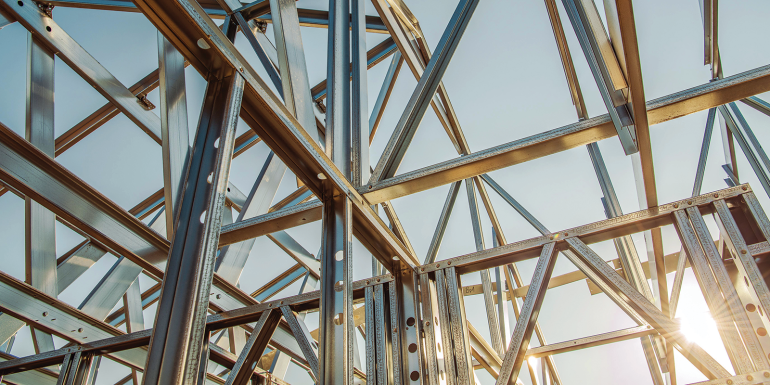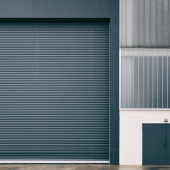Cross UK Report 1195

Collaborative reporting for safer structures. Report 1195: Overloading a portal frame with suspended services.
This report concerns the overloading of a roof due to a concentration of services that were not allowed for in the design.
A reporter designed a single-storey portal frame using an allowance for roof service loading of 0.25kN/m2. After the project was completed, a tenant for the unit took over the fit-out and added a considerable amount of sprinkler pipework into the roof, supported by some newly added secondary steelwork. The reporter was consulted over the effect of the localised point loads applied to the main structure by the installed services and additional steelwork.
During their assessment, the reporter observed a considerable amount of other pipework in other areas of the roof that was supported directly from the cold rolled purlins, generally via a clip-type fixing to the flange. In some locations, the total pipe loads were in excess of 100kg per metre run of pipe, with a significant number of pipes supported by a pair of cold rolled purlins. The reporter goes on to say that the loads, and their local effects, exceeded that generated from the 0.25kN/m2 allowance and could have led to a serviceability failure of the supporting steelwork. This could have compromised the integrity of the roof, led to leaks or led to the partial collapse of the roofing system.
The attachment of the mechanical services to the purlins, with very high point loadings due to the weight of the pipework being filled by water, was also not acceptable, even though the designer’s risk assessment had raised it as a matter to be considered. The reporter goes on to say that clip fixings with large loads can lead to excessive local deformation of the purlin flange and cause the mechanical services to become detached. This would lead to a progressive collapse of the supported services. Fortunately, the sprinkler pipework had not been commissioned and was not full of water. The reporter adds that a programme of remedial works was specified. These included rerouting some services where portal frame stability was impacted.
In the opinion of the reporter, a number of factors contributed to the overloading problem:
- a lack of communication between the fit-out contractor and the main contractor. The fit-out contractor had been employed directly by the tenant. The main contractor was not aware that the fit-out was being done and had not communicated any risks identified by the design team to the fit-out contractor
- a lack of understanding by the fit-out contractor of the need to comply with mechanical services load allowances. Communication with the fit-out contractor showed they did not understand what a service load allowance of 0.25kN/m2 meant in practical terms; and
- a lack of understanding of the capacity of the clip fixings. When challenged about the use of clip fixings to the purlins, the contractor said that they were adequate as the applied loads were less than the specified clip-load capacity. The reporter advised that this may well have been true for the clip itself, but not so for the cold rolled purlin toe, to which the clips were fixed.
Following this experience, the reporter’s firm reassessed what information they would provide as part of the designer’s risk assessments. They decided that they would, in future, issue a document giving practical examples of mechanical services to a load of 0.25kN/m2 supported by secondary steelwork.
As a wider discussion point, the reporter notes that modern industrial buildings tend to have many more services than in the past. In this case, the main culprit was sprinkler pipework, but the reporter’s firm has seen industrial premises with sprinklers, heating, cooling, data and electrical services, all of which are deemed to be within the 0.25kN/m2 services allowance.
The reporter asks if this allowance is still fit for purpose and questions if it should be circa 0.4kN/m2 for buildings without photovoltaic (PV) panels, and 0.55kN/m2 for buildings with PV panels. The reporter also notes that increasing service loads is likely to increase the amount of steelwork being used and will, therefore, have a negative impact on projects, both commercially and environmentally.
Comments
This report underpins the role of designers who, before putting pen to paper and making calculations, need to open a dialogue with the client and/or architect about the function of a structure and what loads are applicable. As services are often unknown at the early stages of a project, a prudent designer might suggest a working allowance, adding that it should be verified at a later stage.
It can be illuminating to ask students, or indeed members of a construction team, what 0.25kN/m2 looks like. Certainly, the fit-out contractor did not appreciate what it meant in comparison with the loads that were going to be applied.
It is always a risk that a carefully thought-through engineering design is compromised by a late and ill-considered addition. There are many examples of where this has led to failure and collapse. Therefore, all changes must be approved by the designer, in this case by the designer of the main structure. It is essential to have good communication with the original client about the future-proofing of the structure – for example, by suggesting that provision is made for additional roof-mounted loads (externally for PV installations, smoke vents and the like, and internally for sprinklers, ducts and other services).
The structural and services designers need to clearly describe the available capacity to the principal designer and provide clear visual information for inclusion in the health and safety file – this is vital when changes are being proposed to the loads on a roof.
The reporter makes the point that services may be heavier than they used to be. Interestingly, old Institution of Structural Engineers manuals, Manual for the Design of Reinforced Concrete (1985) and Manual for Steelwork Building Structures (1989), as well as SCI P359 Composite Design of Steel Frame Buildings (2011), give design allowances of 0.32 to 0.45 kN/m2. The current Institution of Structural Engineers Manual for the Design of Steelwork Building Structures to EC3 (2010) gives between 0.1 to 0.5 kN/m2 for ceiling and service load, depending upon building type. The British Council for Offices recommends 0.24 to 0.49 kN/m2. These put into perspective the very high point loads mentioned by the reporter. Such loads are substantial and would, in almost any circumstances, require special consideration.
The reporter says that high local loads distorted the lip on the cold rolled section, which is potentially a serious weakening of the section buckling capacity and could compromise safety. There is a difference in approach between those who would increase allowances to protect safety and those who want to reduce structures to the bare minimum to protect the environment. It is a matter of individual designer judgment, though the client should always be made aware and agree.
To subscribe to the CROSS UK newsletter (structural and fire safety concerns), visit cross-safety.org/uk/user/register









